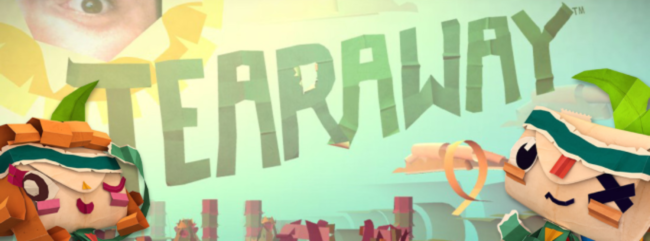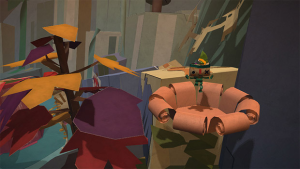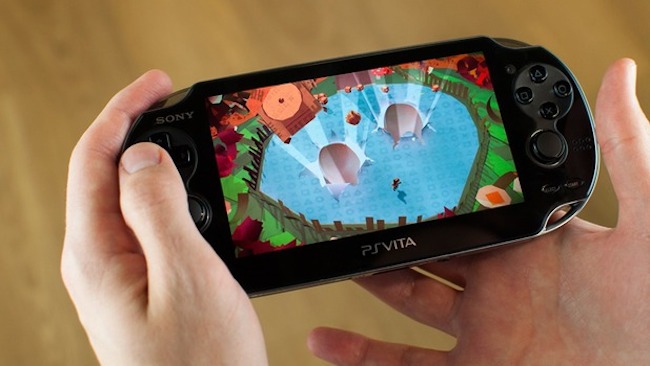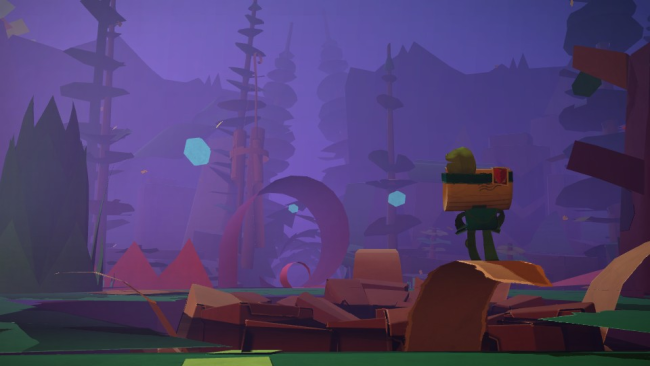
Imagine having an entire world within your hands. A world that you could touch and directly impact, and a world that looked to you for guidance and direction. Now imagine it were a colourful, vibrant world constructed of paper, filled with whimsical, joyous, and all around pleasant creatures and places. This world is called Tearaway.

This is exactly the type of world you’d expect to be created by Media Molecule; the creators of LittleBigPlanet. Unlike LittleBigPlanet though, Tearaway isn’t focused on creating and sharing with others, but creating and sharing with the crafty world in which it takes place, and this is what makes Tearaway a truly special experience. As the player, you become a character in the game (as well as playing as one). Through the magic of the Vita’s front and rear facing cameras, the inhabitants of Tearaway can look out into your world, and both see and hear you as you’re playing. It might come across as a bit of a gimmick at first, but progresses into something meaningful as the game moves forward. As well as succeeding as a fun, playful platformer, it actually becomes quite a touching experience.
You play as either Iota or Atoi, each of which are envelopes come to life, with thin, papery limbs. Your goal as this little papery rascal is to deliver a message (which conveniently is your messenger’s head) to yourself, the player. Your means of achieving this goal include adventuring and platforming through papery fields and cardboard mountains towards yourself, the player. The player and their world are visible in the sun, so the sun is where you head. Iota and Atoi’s abilities start out small; limited to picking up and throwing items, but gradually grow as they learn to jump, roll into a ball, and use a tool to suck in or blow out air (or enemies) called the squeezebox. These abilities and new ways to use them in traversal and exploration are introduced regularly, and all offer a new way to keep platforming interesting. You’ll always be doing something differently than you were 20 minutes prior.

Your messenger’s sweet moves can also be used during combat. A newspaper coated box with a singular malicious eye is called a scrap, and plenty of them will stand between you and your messenger, which must be disposed of in order to progress. Scraps will dive at your messenger, giving him/her/it a chance to evade, pick up, and throw the foe; bursting it into a rain of confetti. As you progress combat will become more complicated, with different enemy types and different techniques needed to defeat them. This removes some monotony from an aspect of the gameplay riddled with repetition, but it isn’t quite enough. There were certain points in the game where I felt I was fighting waves of scraps unnecessarily, and I would have much preferred to have been continuing the adventure, but these moments weren’t regular enough to really diminish the fun of the game.

In the game, players will come across different patterns on pieces of the environment indicate that a certain interaction can be executed with it. Poking your finger through the ground using the rear touch pad, tapping the rear touch pad to make a drum pad bounce anything on top of it, moving objects around and unrolling pieces of paper with the touch screen, and tilting the world whilst tilting your Vita are all ways you can help your messenger to progress. These interactions all make sense within the narrative, and add a lot of differentiation to the gameplay.
At times the player is asked to create a piece of the world, too. Designing and placing paper shapes is reminiscent of Scribblenauts, but without adding much to the game. Rather than anything useful, you’ll draw things you don’t really care about. Rather than crafting a bridge to cross a gap, or a vehicle to traverse a new area, you’ll draw a moustache for a stranger, or eyes for a squirrel. By the end of the game, I had grown weary of scribbling down facial features and taking pictures of my newly customised character, and yet, the game continued to insist I do.

The gameplay of Tearway is reminiscent of an N64 platformer, and as such, I found myself being reminded of Banjo-Kazooie. This similarity is emphasised by the various locations you’ll visit in the game. Green fields, a snowy tundra, an orange desert, spooky caves, a scientific laboratory. You’ll find yourself in all sorts of places beautifully crafted from sheets of paper. Though the graphical fidelity certainly isn’t its strong suit, the folding, tearing world of Tearaway is truly unique, and very interesting. The visual design is original, magical, and fantastic.
The soundtrack it quite competent as well, with plenty of fun, bombastic tunes present throughout the game. Catchy, whimsical songs feel fitting to their respective locales, and I’d be happy to listen to them more. Again, Banjo-Kazooie comes to mind. Though Tearaway features dialogue boxes as opposed to voice acting in most cases, characters will grunt and moan as they speak, and this adds even more charm to such an endearing world.
 Classic 3D platforming
Classic 3D platforming Distinct, original world
Distinct, original world Well implemented touch and motion controls
Well implemented touch and motion controls Connection between the player and the game
Connection between the player and the game
 Combat can become monotonous at times
Combat can become monotonous at times Drawing items gets tiresome quickly
Drawing items gets tiresome quickly
Tearaway is an incredibly charming adventure game that utilises a lot of interesting mechanics and dynamic gameplay. The mixture of traditional platforming combined with the Vita’s touch and motion controls create a unique, interesting gameplay experience that is simply a lot of fun to play. Likable characters, inspired landscapes, and a great soundtrack all add to the games excellent presentation, and the incredible world it aspires to deliver. Though there are certain aspects of the game that can overstay their welcome at times, they’re often negligible enough to excuse entirely. Most pertinently though; Tearaway makes a beautiful statement about the medium of video games, what they mean to the player, and what the player means to them. I not only had a lot of fun playing, but I was left touched. Tearaway is a definitive game for the Vita, and something well worth experiencing.











